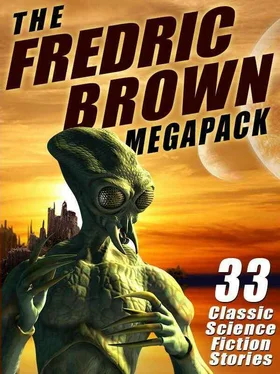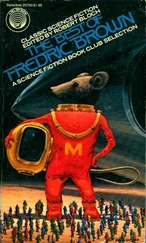“Sure. Why?”
“Come on, then,” he said firmly. “You’re a Linotype technician, and besides you got me into this.”
“Into what?”
“Into this,” he said, and wouldn’t tell me a thing more until we got there. Then he rummaged in all pigeonholes of his desk and pulled out a piece of dead copy and gave it to me.
His face had a kind of wistful look. “Walter,” he said, “maybe I’m nuts, and I want to find out. I guess running a local paper for twenty-two years and doing all the work myself and trying to please everybody is enough to get a man off his rocker, but I want to find out.”
I looked at him, and I looked at the copy sheet he’d handed to me. It was just an ordinary sheet of foolscap and it was in handwriting that I recognized as that of Hank Rogg, the hardware merchant over at Hales Corners who sends in items from there. There were the usual misspellings one would expect from Hank, but the item itself wasn’t news to me. It read: “The weding of H.M. Klaflin and Miss Margorie Burke took place yesterday evening at the home of the bride. The bridesmades were—”
I quit reading and looked up at George and wondered what he was getting at. I said, “So what? This was two days ago, and I attended the wedding myself. There’s nothing funny about—”
“Listen, Walter,” he said, “set that for me, will you? Go over and sit down at the Linotype and set that whole thing. It won’t run over ten or twelve lines.”
“Sure, but why?”
“Because— Well, just set it, Walter. Then I’ll tell you why.” So I went out in the shop and sat down at the Linotype, and I ran a couple of pi lines to get the feel of the keyboard again, and then I put the copy on the clipboard and started. I said, “Hey, George, Marjorie spells her name with a j, doesn’t she, instead of a g?”
And George said, “Yeah,” in a funny tone of voice.
I ran off the rest of the squib, and then looked up and said, “Well?”
He came across and lifted the stick out of the machine and read the slugs upside down like all printers read type, and he sighed. He said, “Then it wasn’t me. Lookit, Walter.”
He handed me the stick, and I read the type, or started to.
It read: “The weding of H.M. Klaflin and Miss Margorie Burke took place yesterday evening at the home of the bride. The bridesmades were—”
I grinned. “Good thing I don’t have to set type for a living anymore, George. I’m slipping; three errors in the first five lines. But what about it? Now tell me why you wanted me to set it.”
He said, “Set the first couple lines over again, Walter. I—I want you to find out for yourself.”
I looked up at him and he looked so darned serious and worried that I didn’t argue. I turned back to the keyboard and started out again: “The wedding of—” My eyes went up to the assembly slide and read the characters on the front of the mats that had dropped, and I saw that it read, “The weding of—”
There’s one advantage about a Linotype you may not know if you’re not a printer. You can always make a correction in a line if you make it before you push the lever that sends in the line of matrices to cast the slug. You just drop the mats you need for the correction and put them in the right place by hand.
So I pushed the d key to get another d matrix to correct the misspelled word “weding”—and nothing happened. The keycam was going around all right and the click sounded O.K., but no d mat dropped. I looked up top to see if there was a distributor stop and there wasn’t.
I stood up. “The d channel’s jammed,” I said. To be sure before I started to work on it, I held the d key down a minute and listened to the series of clicks while the keyboard cam went round.
But no d matrix dropped.
“Skip it, Walter,” said George Ronson quietly. “Send in the line and keep on going.”
I sat down again and decided to humor him. If I did, I’d probably find out what he was leading up to quicker than if I argued. I finished the first line and started the second and came to the word “Margorie” on copy. I hit the M key, the a, r, j, o—and happened to glance at the assembly slide. The matrices there read “Margo—”
I said, “Damn,” and hit the j key again to get a j mat to substitute for the g, and nothing happened. The j channel must be jammed. I held the j key down and no mat dropped. I said, “Damn,” again and stood up to look over the escapement mechanism.
“Never mind, Walter,” said George. There was a funny blend of a lot of things in his voice; a sort of triumph over me, I guess; and a bit of fear and a lot of bewilderment and a touch of resignation. “Don’t you see? It follows copy! ”
“ It—what?”
“That’s why I wanted you to try it out, Walter,” he said. “Just to make sure it was the machine and not me. Lookit; that copy in the clipboard has w-e-d-i-n-g for wedding, and M-a-r-g-o-r-i-e— for Marjorie—and no matter what keys you hit, that’s the way the mats drop. ”
I said, “Bosh. George, have you been drinking?”
“Don’t believe me,” he said. “Keep on trying to set those lines right. Set your correction for the fourth line; the one that has b-r-i-d-e-s-m-a-d-e-s in it.”
I grunted, and I looked back at the stick of type to see what word the fourth line started with, and I started hitting keys. I set, “The bridesma,” and then I stopped. Slowly and deliberately and looking at the keyboard while I did it, I put my index finger on the i key and pushed. I heard the mat click through the escapement, and I looked up and saw it fall over the star wheel. I knew I hadn’t hit the wrong key on that one. The mats in the assembly elevator read—yes, you’ve guessed it: “bridesmad—”
I said, “I don’t believe it.”
George Ronson looked at me with a sort of lopsided, worried grin. He said, “Neither did I. Listen, Walter, I’m going out to take a walk. I’m going nuts. I can’t stand it here right now. You go ahead and convince yourself. Take your time.”
I watched him until he’d gone out the door. Then with a kind of funny feeling, I turned back to the Linotype. It was a long time before I believed it, but it was so.
No matter what keys I hit, the damn machine followed copy, errors and all.
I went the whole hog finally. I started over again, and set the first couple of words and then began to sweep my fingers down the rows of keys in sweeps like an operator uses to fill out a pi line: ETAOIN SHRDLU ETAOIN SHRDLU ETAOIN SHRDLU—and I didn’t look at the matrices in the assembler slide. I sent them in to cast, and I picked up the hot slug that the ejector pushed out of the mold and I read: “The weding of H. M. Klaflin and—”
There was sweat on my forehead. I wiped it off and then I shut off the machine and went out to look for George Ronson. I didn’t have to look very hard because he was right where I knew I’d find him. I ordered a drink, too.
He’d taken a look at my face when I walked into the bar, and I guess he didn’t have to ask me what had happened.
We touched our glasses together and downed the contents before either of us said anything at all. Then I asked, “Got any idea why it works like that?”
He nodded.
I said, “Don’t tell me. Wait until I’ve had a couple more drinks and then I can take it—maybe.” I raised my voice and said, “Hey, Joe; just leave that bottle in reach on the bar. We’ll settle for it.”
He did, and I had two more shots fairly quick. Then I closed my eyes and said, “All right, George, why?”
“Remember that guy who had those special mats cut and rented the use of my Linotype to set up something that was too secret for anybody to read? I can’t remember his name—what was it?”
Читать дальше












